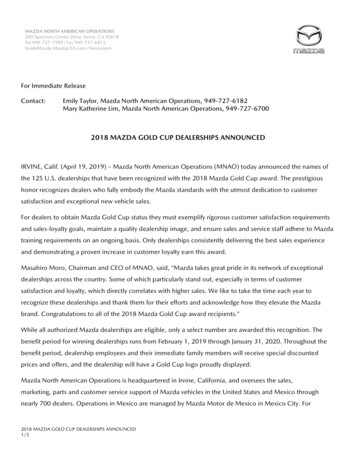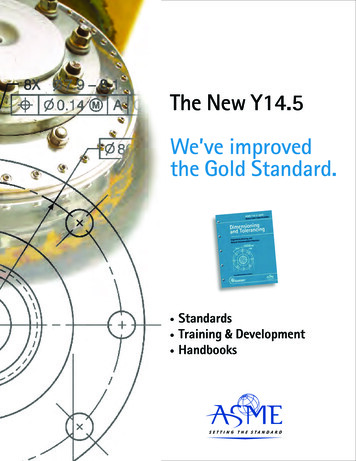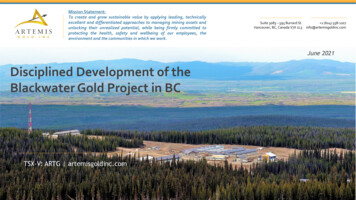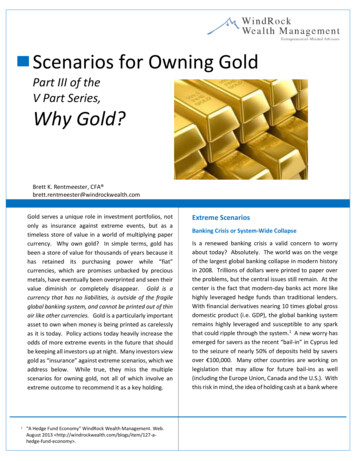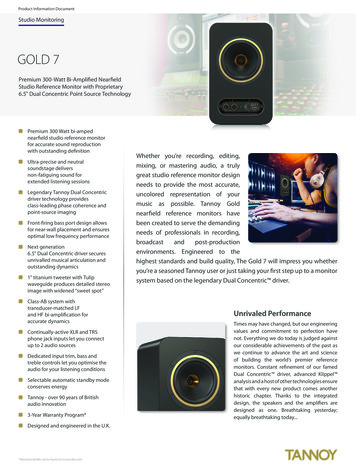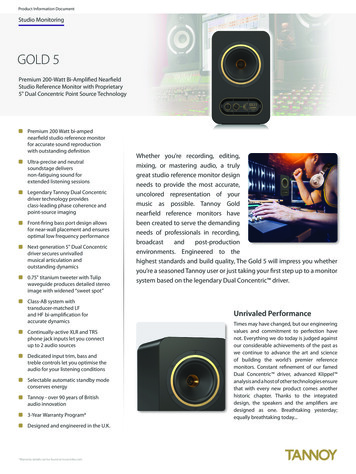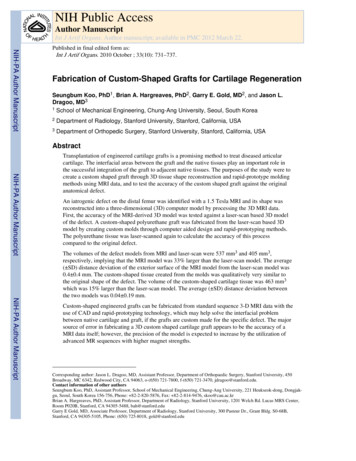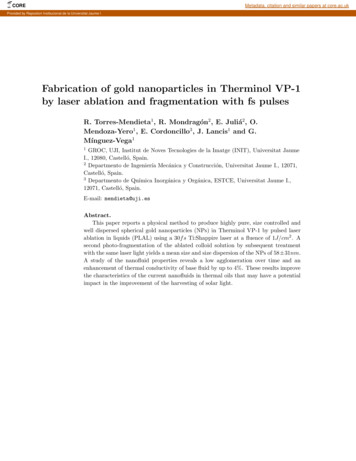
Transcription
COREMetadata, citation and similar papers at core.ac.ukProvided by Repositori Institucional de la Universitat Jaume IFabrication of gold nanoparticles in Therminol VP-1by laser ablation and fragmentation with fs pulsesR. Torres-Mendieta1 , R. Mondragón2 , E. Juliá2 , O.Mendoza-Yero1 , E. Cordoncillo3 , J. Lancis1 and G.Mı́nguez-Vega11GROC, UJI, Institut de Noves Tecnologies de la Imatge (INIT), Universitat JaumeI., 12080, Castelló, Spain.2Departmento de Ingenierı́a Mecánica y Construcción, Universitat Jaume I., 12071,Castelló, Spain.3Departmento de Quı́mica Inorgánica y Orgánica, ESTCE, Universitat Jaume I.,12071, Castelló, Spain.E-mail: mendieta@uji.esAbstract.This paper reports a physical method to produce highly pure, size controlled andwell dispersed spherical gold nanoparticles (NPs) in Therminol VP-1 by pulsed laserablation in liquids (PLAL) using a 30f s Ti:Shappire laser at a fluence of 1J/cm2 . Asecond photo-fragmentation of the ablated colloid solution by subsequent treatmentwith the same laser light yields a mean size and size dispersion of the NPs of 58 31nm.A study of the nanofluid properties reveals a low agglomeration over time and anenhancement of thermal conductivity of base fluid by up to 4%. These results improvethe characteristics of the current nanofluids in thermal oils that may have a potentialimpact in the improvement of the harvesting of solar light.
Fabrication of gold nanoparticles in Therminol VP-1 by PLAL21. IntroductionPulsed Laser Ablation in Liquids (PLAL) is a technique that has gained a lot of attentionsince 1987 when, for the first time, Patil et al. (1) reported the laser ablation of a solidiron target in water. Lately, it was also discovered that by means of this technique ispossible the production of nanoparticles (NPs). In PLAL, the extraction mechanismis usually interpreted on the basis of different physical and chemical processes. Thephysical processes are governed by the laser parameters and the chemical processesmainly by the interaction between the particles and the base fluid. To enhance thecharacteristics of the NPs, after the ablation, the colloidal solution is irradiated again bythe laser to promote another photo-fragmentation process of the NPs in the fluid (2; 3).In particular, the strongest fragmentation effect in the second process is obtained whenlaser fluence is smaller than or about the breakdown threshold of the liquid. Hence, theselection of experimental parameters such as the light wavelength, laser fluence, ablationtime, repetition rate, or the base fluid itself can modify the shape and size distributionof particles (4). For example, the ablation process with laser pulses of few femtosecondstemporal widths allows us to achieve higher purity in the final fluid as well as lower heataffected zone onto the sample than with nanosecond or picosecond pulses (5; 6). Also,the laser-plume interaction is minimized, which makes the NPs generation process morecontrollable and the achievement of breakdown threshold in the fluid easier.Applications of the PLAL technique and the photo-fragmentation additionalprocess include, but are not limited to, the production of NPs of metallic andsemiconductor materials (7–11), the morphological modification of nano-structures(12; 13), or the synthesis of nanomaterials with chemical active fluids without needing aphysical target (14; 15). Synthesized like-flower NPs with potential abilities for surfaceenhanced Raman Scattering was also proved by Lu et al. (16). Recently, the selectionof the base fluid has been shown to be a key parameter in many applications such asthe development of high speed and frequency electronic devices (17; 18) or the synthesisof non-toxic NPs that present infrared emission for biomedical applications (19; 20).On the other hand, the concept of adding small solid particles into a fluid to increasethe thermal properties of the suspension has been practiced since 1873 (21). However,most of the studies were performed using suspensions of millimeter- or micrometer- sizedparticles, which led to problems such as poor suspension stability and channel clogging,which limits its practical applicability. To solve these drawbacks in 1995, S. U. S. Choiproposed the use of nanofluids to increase the thermal conductivity of heat transferfluids (22). Nanofluids are defined as dilute suspensions with solid NPs.Thermal oils are widely used in several industrial applications such as solar thermalpower plants. Solar energy is one of the best sources of renewable energy with minimalenvironmental impact. Nowadays, the improvement of the harvesting of solar light is achallenge. One way to increase the efficiency in solar thermal collectors is by fabricatingnanofluids using a thermal oil such as Therminol VP-1 as a base fluid (23; 24).In this context, Wang et al. (24) experimentally demonstrated that the fabrication
Fabrication of gold nanoparticles in Therminol VP-1 by PLAL3of spherical gold NPs with sizes around 121nm and concentrations of 0.05% (masspercentage) in Therminol VP-1 can enhance its thermal conductivity by up to 6.5%,increasing in this way the harvesting of energy in solar plants. This happens at least3 days before that the agglomeration of NPs and increment of viscosity appears (it isconsidered that an increment in nanofluid viscosity is a drawback due to the associatedincrement in fluid pumping costs). Note that, in the procedure followed by Wang etal., gold NPs are commonly produced in form of colloidal suspensions into a givensolution separately, and subsequently dispersed into Therminol VP-1. Hence, theagglomeration of NPs cannot be disregarded, leading to poor suspension stability andhigh shear viscosity. In order to mitigate this unwanted effect alternative proceduresbased on the production of NPs directly into the fluids have been proposed (25–28).Unfortunately, most of them (i.e., wet techniques) demonstrate low effectiveness toavoid the NPs agglomeration and/or show pollution problems due to the surfactantsused in the synthesis of NPs.In this paper we experimentally demonstrated the fabrication of a thermal oilnanofluid based on femtosecond laser ablation and re-fragmentation of bulk gold insideTherminol VP-1. The morphology, purity, mean size, size dispersion of our NPs and thestability and thermal conductivity enhancement of the nanofluid are determined. Owingto the fact that no chemical stabilizer, reductor or dispersant are employed to synthesizethe NPs and thanks to the photo-fragmentation process we obtain small particle sizeand the agglomeration over time is significantly alleviated. This may have a potentialimpact in using this nanofluid in real applications as in thermal power plants.2. Experimental setupIn our experiment we produce gold nanoparticles in Therminol VP-1 by PLAL followedby a second photo-fragmentation process. The first stage of the experiment involves alaser ablation process where the ejected fragments of material produced by the ablationare captured in a liquid (in this case we used Therminol VP-1). It was carried outwith a Ti:Sapphire laser (Femtopower Compact Pro, Femtolasers), that emits pulsesof 30f s intensity full width at half maximum (FWHM) with a central wavelength of800nm, maximum energy per pulses of 0.5mJ, and 1kHz repetition rate. Before exitthe ultrashort pulses pass through a user-adjustable post-compression stage based ontwo fused silica Brewster prisms which allows us to control the dispersion in the beamdelivery path. The energy of the pulses was measured with an analogical power-meter(Spectra Physics, Model 407-A) and controlled by using a set of calibrated neutraldensity filters. The cross-section of the pulsed beam was slightly elliptical, with anominal beam diameter of 15mm in accordance with the 1/e2 criterium, and a beampropagation factor lower than two. To reduce optical aberrations and increase the spatialuniformity, the beam passes through a 2x all-mirror beam expander. In addition, aniris of 6mm of diameter is placed before the focusing optics.A gold disc of thickness 1mm and diameter 6.5mm (99.99% purity) was used as the
Fabrication of gold nanoparticles in Therminol VP-1 by PLAL4target. The gold target was placed at the bottom of a glass vessel (cuvette) filled withTherminol VP-1. The thickness of the fluid layer above the target was about 7mm. Thecuvette was attached to a 2-D motion controlled stage which can be moved at a constantspeed during the experiment. The target was irradiated from the air-liquid interface bymeans of a focused beam with a lens of 75mm focal length onto the target surface whilemoving the target, perpendicular to the beam propagation axis, at a constant velocity of4.5mm/s. The dispersion introduced by the liquid and the lens was compensated withthe help of the above mentioned post-compression stage. To adjust the duration of theablation process, an electronically controlled shutter was utilized. In these conditions,after 15 17min we obtained a brown coloration in the aqueous solution due to thepresence of the gold nanoparticles in the fluid.In the following experimental stage, we filled a 10ml glass cuvette with the NPcolloidal solution obtained from the first stage of the experiment. Then, the cuvettewas irradiated by using the light from the Ti:Sapphire laser, previously focused onto itscenter with the same lens, while the suspension was stirred by a magnet to homogenizethe photo-ablation process which consist of a fragmentation of the biggest particles intosmaller particles by means of a second ablation process.Under free propagation, the fluence of the laser beam at the focal point of thelens is about 1J/cm2 . However, due to the refraction effects this value decreases until0.6J/cm2 approximately. Please also note that the laser fluence inside the cuvette isnot constant, but decreasing as we move away from the focal position towards the lens.3. Results and discussionIn this section by using Transmission Electronic Microscopy (TEM), Energy DispersiveX-ray Spectroscopy (EDX), High Resolution Transmission Electronic Microscopy(HRTEM) and Dynamic Light Scattering (DLS) we determine the morphology, purity,mean size, size dispersion, and stability of the fabricated and commercial NPs. Thissection is divided in two subsections, the production of NPs where we will focus inthe properties of the nanofluid just after its fabrication and the section called nanofluidproperties where we will study some characteristics of our nanofluid such as the evolutionof the mean size of the particles through the time and the nanofluid thermal conductivity.3.1. Production of nanoparticlesTo study the quality of the NPs fabricated with the f s laser we compare their propertieswith commercial NPs added to Therminol VP-1. In order to obtain highly dispersedNPs, similar to the ones obtained by the PLAL technique, commercial gold NPs areacquired in aqueous suspension from Sigma Aldrich. NPs are stabilized in 0.1mM ofphosphate buffered saline (PBS) solution and the primary particle diameter is 50nm.To prepare Therminol VP-1/gold nanofluids, first water content is removed from theaqueous nanofluid by evaporation in a hot plate. The solid product obtained is then
Fabrication of gold nanoparticles in Therminol VP-1 by PLAL5dispersed in Therminol VP-1 with the help of an ultrasound probe and a concentratednanofluids is obtained. The sonication time varies from 5 to 10min depending on thesample volume. Finally, nanofluids are diluted with pure Therminol VP-1 to achievethe same optical density and solid content in all the cases. Optical density has beencalculated by measuring the radiation absorption of a laser beam at 635nm (ModelCPS180, ThorLabs) with a photodiode (Model SM05PD1B, Thorlabs) in a rectangularquartz cuvette.To determine the morphology of the gold NPs and the purity of the final material,a droplet of the colloidal suspension of Therminol VP-1 with NPs was dispersed ontoa carbon-coated copper-based TEM grid. The liquid content was then removed withthe help of an absorbent paper so the solid particles can remain in the grid surface.This technique allows obtaining dry particles highly dispersed and the morphology andparticle size of the primary particles can be determined. The micrographs shown inFigure 1 a) - c) were obtained with a TEM (JEOL 2100 microscope) operating at avoltage of 100kV . Figure 1 a) and Figure 1 b) correspond to samples synthesized byPLAL and PLAL followed by the second photo-fragmentation process, respectively,whereas in Figure 1 c) the sample was generated by addition of commercial gold NPsinto Therminol VP-1 as explained above. From the results, it is clear that in contrastwith the quasi-ellipsoidal particles shown in Figure 1 c), the morphology of the particlessynthesized with PLAL is mostly spherical.Figure 1. TEM micrographs of samples fabricated by a) PLAL b) PLAL followed bythe second photo-fragmentation process, and c) commercial NPs.To ensure the purity of the gold NPs obtained with the femtosecond laser, anelemental composition of the NPs was determined using an EDX system attached tothe TEM (an Oxford Instruments INCA Penta FETX3). The EDX detected gold (Au),copper (Cu) and carbon (C) (see Figure 2 a)). However, the presence of copper andcarbon is caused by the fact that the grid substrate is made of copper and it containsa carbon film. In this direction, we also performed HRTEM measurements to seethe crystallographyc planes of the gold NPs and corroborate our results. Figure 2
Fabrication of gold nanoparticles in Therminol VP-1 by PLAL6b) shows four typical spherical Au particles with diameters less than 5nm, embeddedin the thermal fluid. The clear lattice fringes indicate the high crystallinity. The insetin Figure 2 b) allows us to see the crystallographic planes. As might be expected,the d interplanar spacings represented by (hkl) Miller index obtained from HRTEMmicrographs in Table 1 are similar t
dispersed in Therminol VP-1 with the help of an ultrasound probe and a concentrated nano uids is obtained. The sonication time varies from 5 to 10min depending on the sample volume. Finally, nano uids are diluted with pure Therminol VP-1 to achieve the same optical density and solid content in all the cases. Optical density has been calculated by measuring the radiation absorption of a laser .

